Chapter 4
STOREKEEPER
During the battle, one of the bombs exploded in a storeroom killing several of the storekeepers and the ship was in need of replacements. Gordon and Tommy were tired of being in the deck division with all of the work details involved. One work party consisted of carrying a halve of a beef on their shoulders from the dock to the freezer compartments deep inside the ship. Gordon and Tommy noticed the storekeepers standing on the dock with a pencil and a paper keeping track of the beef that was being brought aboard. Right then they decided that was the kind of job to have.
When the positions came
available, they put in their requests, Tommy was accepted for general
ship supply and Gordon for aviation supply. In September, Commander
Scirka (the supply officer) gave him the rate of Seaman 1st Class.
His new assignment was working in the storeroom where the parts for
the planes were kept.
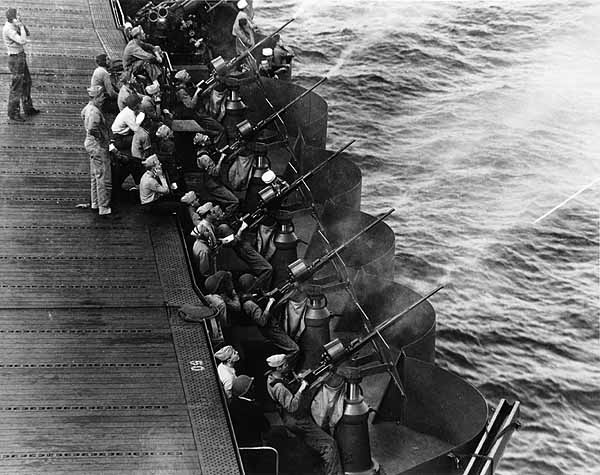
The forward 20 MM battery on the starbord
side was Gordon's next battle station.
One of the men he worked with in the storeroom was Edwin Stanislawski. Gordon and Ski soon became good friends. He moved his army cot into the storeroom and set it up amongst the carburetors. There were some lockers nearby and he finally had more suitable quarters. Ski and some of the other storekeepers had already set up house-keeping in that corner of the store room. About the same time, his battle station was moved from Battery Twelve to the 20 millimeters just ahead of the island structure, between the 40 millimeter mounts (which had replaced the 1.1's during the repairs) and the five inchers.
After being overhauled and put back in order, on October 16th the Enterprise went back to sea, and back to Guadalcanal, and back to war. The voyage back to the South Pacific was Gordon's seventh crossing of the equator. In the meantime, the Wasp had been sunk in September and the Saratoga had been torpedoed again and was in the States for repairs for several more months. The only carriers left were the Enterprise and Hornet. On October 26, 1942 the American and Jap navies engaged in yet another sea battle for Guadalcanal. This one near Santa Cruz Island in the Solomon chain.
When General Quarters was sounded in preparation for battle, Gordon was the last man out of the storeroom and dogged the hatch behind him. As he slammed it shut, somehow his ring got caught. As soft as gold is, it bent in two tearing it right off his finger. At the time he didn't know it happened.
As the Battle of Santa Cruz began, the Enterprise was hidden in a rain squall. The first wave of Japs unloaded their fury on the Hornet. When they were finished, the Enterprise was the only American aircraft carrier left in the Pacific Ocean. By the end of the day, it narrowly escaped not being there either. With the useless and abandoned Hornet drifting about, the Japs returned for the Big E.
For the first four
minutes, she successfully evaded any hits. Then the first bomb ripped
through the forward overhang of the flight deck exploding deep in the
bow area. In the same minute, a second bomb hit just behind the
middle elevator and exploded on the hanger deck. The Jap dive bombers
still poured out of the sky. There was one more direct hit that shook
the ship and the battle appeared to be over. Five minutes later the
Enterprise was attacked by several torpedo bombers from all
directions. Due to the maneuverability of the ship, the marksmanship
of her gunners, and the fighter pilots who flew from her deck, no
hits were scored. Four torpedoes were dropped but the twisting
carrier maneuvered to avoid them. Three of them passed on the port
side, and one to starboard. Gordon was firing at a plane as it glided
down to drop it's torpedo. He saw the torpedo drop into the water and
streak toward the ship. Once again, captain ordered a hard turn and
the big ship paralleled the track of the torpedo. Gordon watched it
speed by just a few yards from the ship.
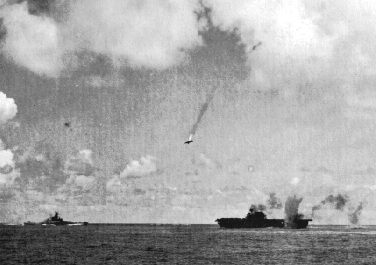
Enterprise at the Battle of Santa Cruz
Another time, after dropping it's torpedo, a plane flew right along side of the ship. Gordon could see the rear seat gunner was standing up in the open cockpit firing his machine gun at the men at their battle stations along the edge of the flight deck. It was so close that he got a good look at his face. It zipped by so close and so fast that they weren't able to train their guns on it. The torpedo was dropped so close to the ship that it didn't have time to arm, so it didn't go off when it hit just aft of the bow.
It was a hot October day and the South Pacific sun was bright and everyone was sweating. Gordon's 20 millimeter was next to the five inch guns. As they spewed projectiles from their barrels, the hot powder cinders were falling onto his back. At the same time, they were being strafed by some Zeros. The powder cinders stung and the sweat running down his back felt like blood. He got weak and scared because he thought he had been hit.
Some were not so lucky. Once Gordon watched a man die. A sailor at one of the guns next to his got hit and fell to the deck. As he laid there in the catwalk, Gordon lost touch with the battle for an instant as he watched the life go out of the quivering body. The thought ran through Gordon's mind that he was glad that wasn't him. He worried about when his number would come up because the odds couldn't be in his favor forever. It wasn't so much the bomb or bullet that had his name on it that concerned him. He figured he could dodge that one. It was the ones that said “to whom it may concern” that worried him.
By now, the Big E's bow
settled low in the water and smoke poured from the holes in the
flight deck. Her aircraft, as well as those from the soon to sink
Hornet were still in the air with no place to land. Soon the fires
were putout out and the returning aircraft began coming aboard,
dodging the craters in the deck.
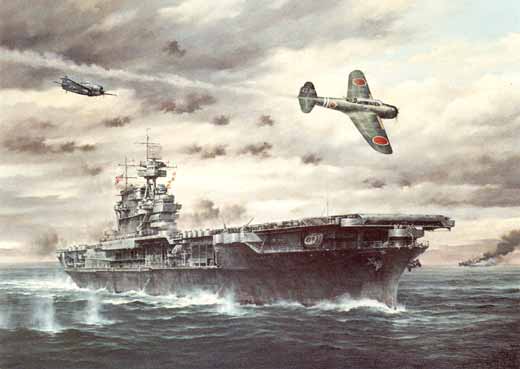
A painting of the Enterprise at the Battle of Santa Cruz by Marii
Chernev. The plane in the foreground is a Kate torpedo bomber.
Only a few touched down before the wounded ship came under attack again. Several bombs exploded dangerously close in the water but not hitting the ship. One of these near misses went off in the water not far from the battery where Gordon was. The force of the explosion bent and twisted the gun deck and threw the gunners up to the flight deck. Gordon got up and ran back to Battery Twelve, where he used to be, and resumed the fight.
It had been a long, hard day. At one point during the battle, the Enterprise's survival was questionable. The gallant crew fought hard to save their ship. If it would have become necessary to abandon ship, Gordon was to stay aboard with the skeleton crew of seven hundred and fifty men to bring the ship in, if possible. He always wore a hunting knife on his belt in case he ever had to abandon ship. At least he would have something use a weapon or a tool. With everything under control, the ship received her air group aboard as well as the Hornet's.
Coming back to the storeroom after the battle, Gordon and Ski weren't able to get into the store room at first because the hanger deck was covered with water and foam and had to be cleaned up before they open the hatch to the storeroom. There was a thousand pound bomb on a cart that had broken loose. As the ship rocked back and forth in heavy seas the bomb cart rolled back and forth across the deck. A sailor was trying to catch it so he could secure it. At first Gordon and Ski thought it was comical. Then it dawned on them that it really wasn't that funny and decided they had better get out of there. Finally when they were able to open the hatch and renter the store room, there was his ring lying on the deck. Then his finger started to hurt.
When Gordon was thrown to the flight deck, his legs were hurt. After the battle they were stiff. He was put in the sickbay to keep him off his legs for a few days. At the same time, they took an ingrown boil from under his arm. While he was in the sick bay, Admiral Kincaid came to visit the men. In talking to Gordon, he asked, "Did they hurt you, son?”
"No, sir. Admiral."
"Good, good." as the Admiral shook his hand. "But we sure raised hell with them if that does you any good."
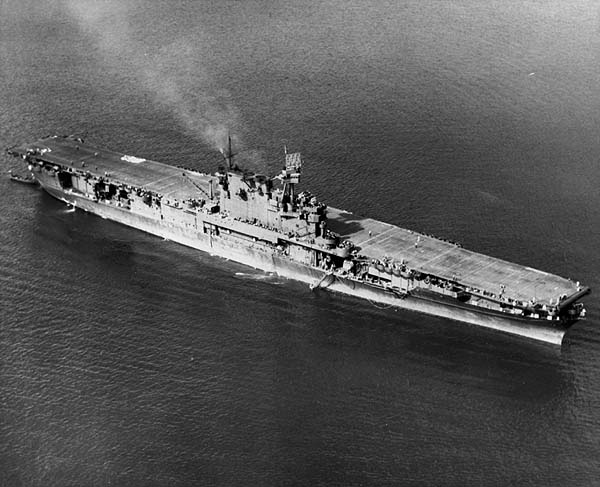
The Enterprise at Noumea - November 1942
When the battle over, Japan
was the looser, despite the loss of the Hornet. They lost at least
one hundred aircraft and two of their carriers were so badly damaged
that they would not see action again for many months. The second
attempt to recapture Guadalcanal was halted. Four days later on the
30th, the Enterprise dropped anchor in the harbor at Noumea, New
Caledonia to lick her wounds.
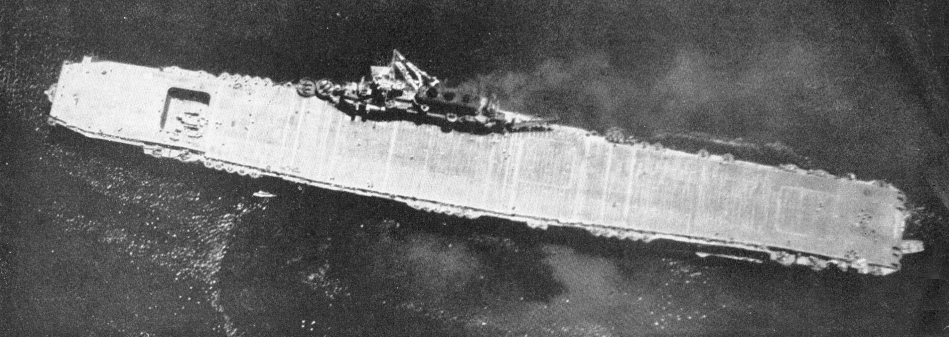
Another view of the Enterprise at Noumea in November 1942
Less than three weeks
after the Battle of Santa Cruz, the Enterprise had not yet fully
recovered form her battle damage. Regardless, she sailed into battle
again on 11th of November. Friday the 13th was a lucky day for the
Enterprise. She helped stop the Japs final attempt to recapture
Guadalcanal. The Enterprise escaped being attacked by hiding in a
rain storm. She returned safely to Noumea on the 16th to finish
repairs.
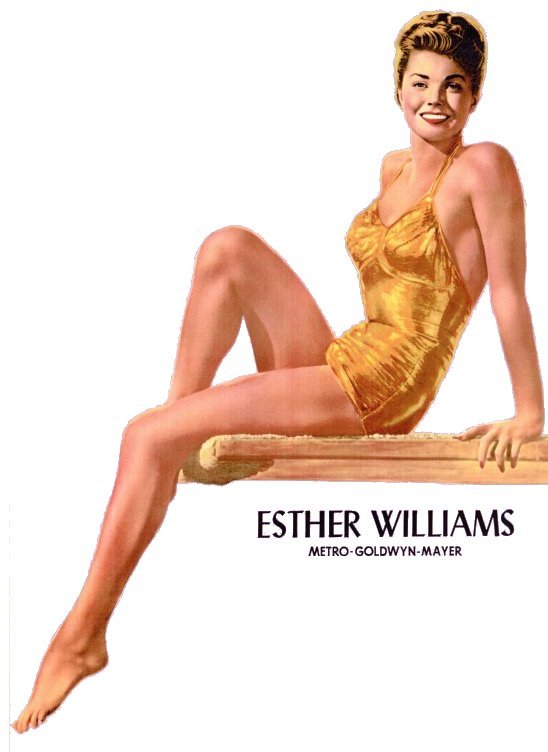
A movie poster for Ester Wiliams circa 1942.
By December, the Saratoga was back in the area after being repaired. Christmas was different at a tropic island with no snow or pine trees. To make it even worse, Bing Crosby's “White Christmas” had just been released and was played over the ships sound system. It caused the throats to swell and eyes to cloud for many crusty, battle weary sailors, Gordon included.
They would hang up a screen on the hanger deck to show the latest movies (as soon as they could reach the war zone). It was supposed to boost moral, but sometimes they induced homesickness. Once they showed a movie staring Esther Williams that took Gordon out of the war to be with her on a sandy beach, if only for a moment. Esther Williams was a competitive swimmer and actress who starred as a bathing beauty in several movies of the time.
The Enterprise put to sea again on December 4th, once more in top fighting condition. The Enterprise spent the next several months either anchored in the tropical ports of Noumea or Espiritu Santo, on patrols, or raiding Jap islands. On January 30, 1943 she participated in the Battle of Rennell Island by providing air cover for a force of cruisers and destroyers that had been attacked by land based bombers which resulted in the loss of one cruiser.
During the next four months the Enterprise patrolled the South Pacific and conducting training exercises with the Saratoga and other elements of the fleet. She rotated back and forth between Noumea and Espiritu Santo in the New Hebrides Islands. Once while anchored at one or the other, Gordon and Ski went over to a supply ship that was also anchored in the same harbor to see what they could round up. Gordon recognized the Ensign they were talking to and asked him, Aren't you was Jack Roper from Burley, Idaho.” Jack responded, “Yeah, and you are … Taylor? No. Gordon Buttars. What ship are you on.”
Gordon pointed across the harbor to the Enterprise and said, “That ship over there.” Not long after that the supply ship sailed for the west coast and Jack went home on leave. While there he went out to see Gover and Mary and told them about having seen Gordon.
On April 1, 1943 Gordon received an advancement, becoming a Petty Officer, rated as a Storekeeper Third Class.
The Enterprise sailed for
Pearl Harbor on May 1, 1943. On the voyage, Gordon crossed the
equator for the eighth time. On May 8th the Enterprise returned to
Pearl Harbor for the first time in seven months. On May 27th, Admiral
Chester Nimitz came aboard and presented the Enterprise and her crew
with the Presidential Unit Citation which read: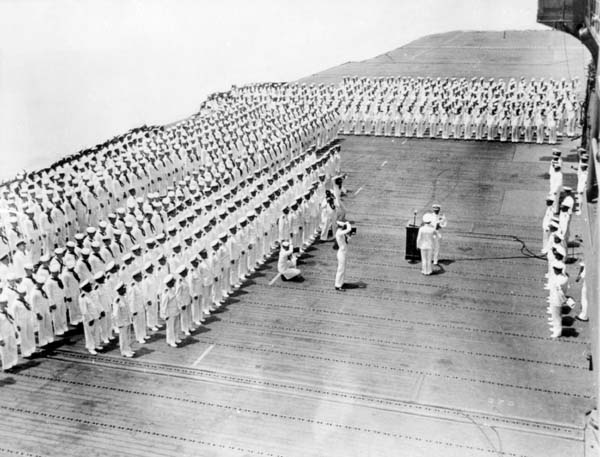
The crew of the Enterprise receiving the
Presidential Unit Citation - May 27, 1943
For consistently outstanding performance and distinguished achievement during repeated action against enemy Japanese forces in the Pacific war area, December 7, 1941, to November 15, 1942. Participating in nearly every major carrier engagement in the first year of the war, the Enterprise and her air group, exclusive of far-flung destruction of hostile shore installations throughout the battle area, did sink or damage on her own a total of 35 Japanese vessels and shoot down a total of 185 Japanese aircraft. Her aggressive spirit and superb combat efficiency are fitting tribute to the officers and men who so gallantly established her as an ahead bulwark in the defense of the American nation.
The Big E spent the next two and a half months and operating in the Hawaiian area conducting training exercises with the brand new Essex. On July 14, 1943 she sailed for Puget Sound for repairs, arriving at Bremerton, Washington on the 20th.
Gordon hadn't been in the
United States for a year and a half and it was good to be home. His
dad was anxious to see him. Gover, Ralph, and Orvin came to spend a
week in Bremerton to visit with Gordon even though he'd be home in
three weeks for an entire month. Gordon tried to tell his dad that he
would be home in three weeks, but he insisted on coming because he
was afraid that the ship would have to leave and he wouldn't be able
to come home. Gover wanted to go aboard and see what the Enterprise
looked like. Gordon got permission from the Executive Officer for him
to come aboard and had the papers and everything. But Gordon was
leery of letting him see the ship in the condition the ship was in.
It was all torn up inside so the repair crews could rebuild it. If
Gover saw it in the shape it was in, knowing his son had to go back
to sea on it, it would probably have haunted him. So Gordon decided
to tell him that he was unable to go aboard. Gover was content with
seeing the Big E at a distance. He never did tell his father that he
had it all arranged. 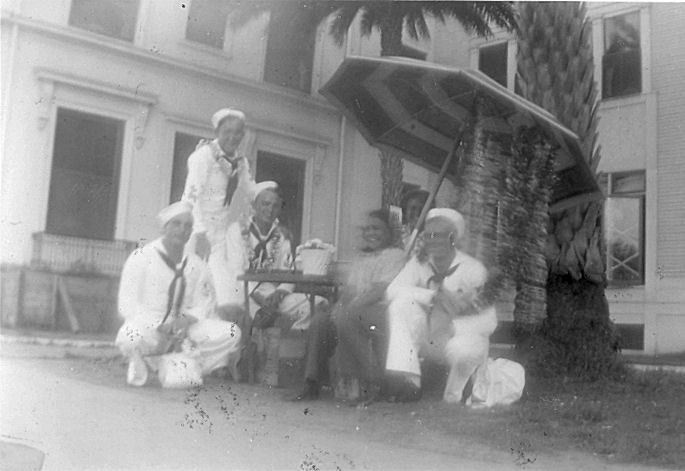
Gordon (left) and some shipmates at the Royal Hawaiian in
June or July 1943
Gordon came home to Burley
on a thirty day leave around the 20th of August. Jack Roper also
happened to be home on leave at that time. Mr. Roper, Jack's father
and the owner of Roper's Fine Clothing, invited Jack and Gordon to
attend a Chamber of Commerce luncheon in the Old National Hotel. Mr.
Roper introduced Gordon and asked him to say a few words. Gordon
Stood up and said, “I haven't much to say, other than I am glad to
be home.” And then he sat back down.
Orvin, Ralph, Gordon, and Gover
August 1943
Then they asked Jack to say a few words. He stood up and said, “I really don't have much to say, either. You see, I am on a cargo ship and where I go the sea lanes are open, because Gordon opened them.” Then he proceeded to describe all that the Enterprise had done and been through. When he was finished, Gordon wished he was a little mouse and could go hide in a hole in the wall because he didn't like having the attention drawn to him.
While home on leave he got
some well deserved rest and did a little work around the farm,
leaving the war behind... Or did he? One day he went into Nelson's
Cafe for coffee. He saw a Jap setting at the end of the counter
having lunch. When the waitress asked Gordon what he wanted, he said,
“That Jap!” She told him that there was a whole bunch of them in
the kitchen. He got up and made his way to the unsuspecting man who
was on his lunch break. Being a sailor who had been trained to hate
and kill Japs, his natural reaction was to attack. Gordon grabbed
the Jap's plate and flung it down the counter. As it slid along, it
knocked everything else off of the counter and it landed in the lap
of a man wearing a suit at the end of the bar. Then he grabbed him by
the throat and tried to choke him to death. Another waitress tried to
stop him but Gordon back handed her, knocking her to the floor.
Finally, a soldier (also home on leave) pulled him off.
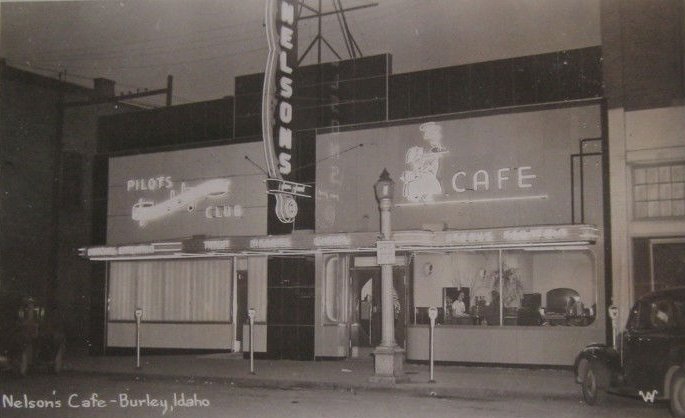
Nelson's Cafe in Burley - during the 1940s
Gordon then ran into the kitchen and got a hold of a meat cleaver and chased all the Japs out on the sidewalk. Once outside, the Police Chief tried to put him in his police car. At first Gordon resisted, but then he thought that if he could get in the car he get the Chief's gun. Then the Chief tried to keep him out of the police car. Finally, a couple of Gordon's friends came and got him and took him home. With the war in the Pacific so many thousands of miles from Burley, Idaho, Gordon had just fought the Battle of Nelson's Cafe.
After that, he stayed home
for a few days. When he finally got up the nerve to go into town, he
left his uniform home and wore civilian clothes. He didn't dare go
near Nelson's, so he went in the Oregon Trail Cafe to get something
to eat. There was the fellow who got the Jap's plate in his lap. He
came over to talk to Gordon and asked him if he was the sailor who
was "raising hell" in Nelson's the other day.
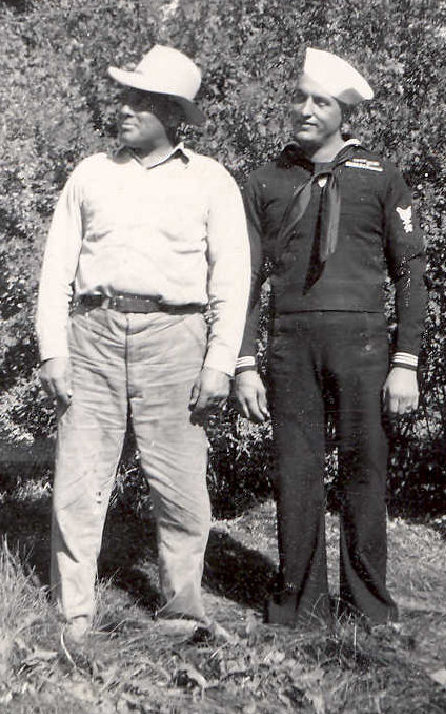
Gover and Gordon - August or September 1943
Gordon told him, "No. I'm just a farmer out here south of town, but I heard about it."
He responded, “You sure look like him.” Just then the man moved in his seat and his jacket folded open enough for Gordon to see that he had a gun in a shoulder holster. Then he did get scared! Figuring he was an FBI agent or something, Gordon decided he had better level with him and told him his story. Nothing more was ever said or done. If he was an FBI agent, he was probably there to keep an eye on all of the Japanese-Americans who had been relocated from the west coast when the war began.
While home on leave, he took it to Scholer's Jeweler in Burley and got it fixed. He wore that ring for the rest of his life and you could still see where it had been bent.
After a month at home in Burley, Gordon went back to the ship. He ended up on a bus full of older women. He was tired and worn out and fell asleep. After a while, his own snoring woke him up. All of those ladies were looking at him and smiling. He figured they must have felt sorry for that poor little sailor.
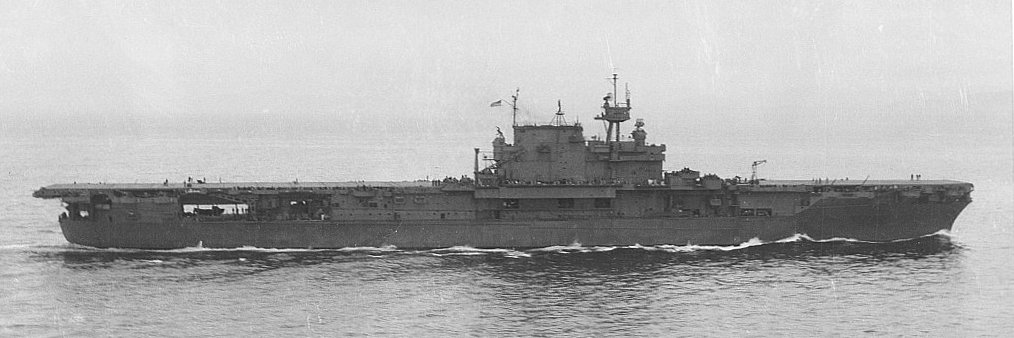
Enterprise in October 1943 after her refit at Bremerton, Washington
The Enterprise back in
tip top shape, as good as new. Actually better with the addition of
numerous 40 millimeter mounts and a new radar set. Gordon's battle
station was now on the 40 millimeters. On the 1st of November she
left Bremerton and was back at her berth in Peal Harbor on the
evening of the 6th. Pearl Harbor was full of ships. There were brand
new carriers, some of which bore the names of The Big E's former
running mates. There were new battleships as well as those that had
been resurrected from the waters of that very same harbor. Among the
cruisers and destroyers were those familiar to the men of the
Enterprise along with brand new ones. Pearl Harbor was also filled
with transports and cargo ships loaded with men and material ready to
begin the island hopping campaigns across the Central Pacific.
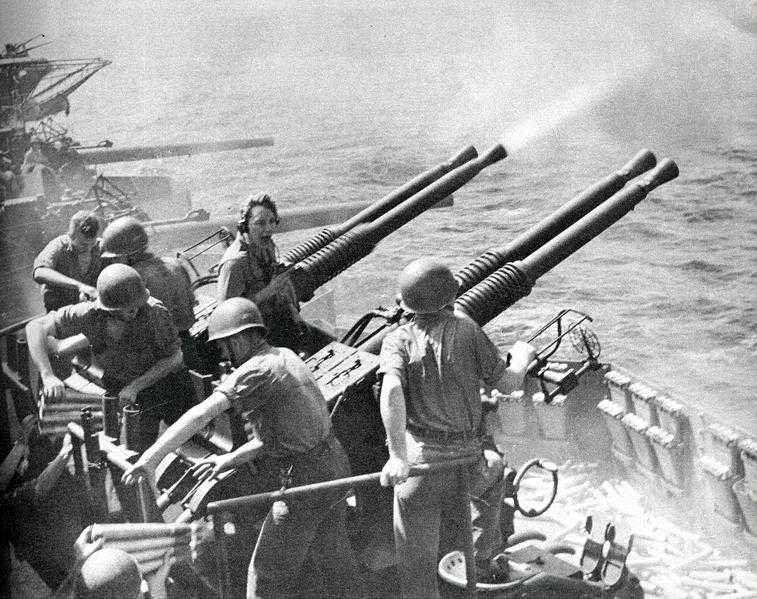
40MM gun mount (on another carrier)
The Enterprise departed Pearl Harbor on November 10, 1943 and sailed into action. For the men aboard the Big E it was a whole new ball game. They found themselves sailing in company of a large task force, one of five large carrier task forces. No longer was the Enterprise alone to suffer the wrath of Nippon's warlords. From November 19th through the 26th Enterprise participated in the occupation of Makin, and on December 4th carried out an attack on Kwajalien. Enterprise than returned to Pearl Harbor on the 9th of December. During that time, Gordon was received a rate advancement to Storekeeper Second Class which took affect on December 1st.
In January of 1944, Gordon
was transferred from the store room to the aviation issue room. The
issue room was the office for the aviation supply room. There were
some bunks and lockers located in the issue room. It was better than
the makeshift quarters he had improvised in the store room. At the
same time his battle station was changed from the 40 millimeters to
the aviation issue room. He had been a gunner for so long that his
effectiveness had worn off.
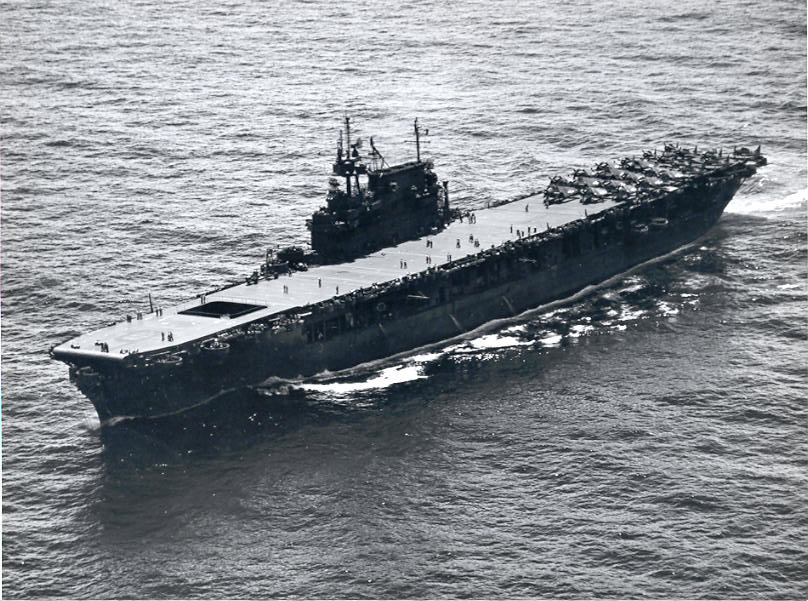
Enterprise late 1943 or early 1944
Gordon knew a lot of pilots better than he knew the crew. They would come back to the storeroom where there was always a fresh pot of coffee and sat around Gordon's desk to shoot the breeze. His desk was the main attraction because it was covered with pinups, overlaid with a sheet of glass. He and Ski also had a still hidden among the carburetors with which they made their own brew. Once during stormy weather, the ship was rocking with the rough seas and their still tipped over. Burning alcohol ran across the deck. Gordon and Ski quickly smothered the flame before it got away from them.
After a months stay in Pearl Harbor, Enterprise departed Pearl Harbor with the rest of the fleet in support of an ambitious island hopping campaign that pushed deeper into Japanese held territory. On the 22nd of January Gordon crossed the equator for about the ninth time. On this particular crossing, there was time to initiate the hundreds of polliwogs on board into the “Solemn Mysteries of the Ancient Order of the Deep”. By this time Gordon was a very crusty shellback. On the 29th planes from the Enterprise attacked the island of Taroa and from February 1st through the 4th participated in the occupation of Kwajalien, both in the Marshall Islands. On the 5th of February the Enterprise dropped anchor in Majuro Lagoon.
Majuro had been captured from the Japanese only a few days earlier. Majuro Lagoon was an ideal anchorage for the fleet. It was one hundred and fourteen square miles of shallow water enclosed by a ring of sixty four small atolls. It was within close range of the objectives the Navy and Marines were concentrating on during the campaign. It did not have the facilities and amenities offered by Pearl Harbor. For example, there was no opportunity for shore leave. All of the reprovisioning was provided for by store ships which were designed to provide the necessities for the fighting ships in advanced anchorages such as Majuro.
Over the next few months,
Enterprise was in and out of Majuro on a regular basis. On one
occasion Gordon and Ski Gordon and Ski learned that there was an
aviation store ship in the lagoon and went over to check it out. On
going aboard, they got excited and hurried back to the Enterprise to
get the necessary paperwork and a barge with a work detail and went
back to the supply ship. By the time they got back to to the Big E,
they had more than their supply rooms could hold. They had to keep
engines on the hanger deck, wings were tied to the overhead beneath
the flight deck, and they put things anyplace they found room.
Because of Gordon and Ski, The Enterprise always had the best supply
of parts of any carrier in the fleet. Once in a while, a plane from
another carrier came aboard just to get fixed. Gordon new all of the
part numbers, where they where, and how many there were in stock. 
Enterprise (left) and other ships at anchor in Majuro Lagoon
On the 12th of February the Enterprise departed Majuro to participate in two days of attacks, along with the rest of the fleet, on Truk, Japan's Pearl Harbor, in the Caroline Islands. After two days of attacks on the 16th and 17th, The Enterprise was then detached from the main fleet and carried out raids on Jaluit on the 20th. Jaluit was one of the atolls in the Marshalls that had been bypassed during the occupation of the island chain. The Enterprise dropped anchor again at Majuro on the 21st for a brief stay.
After two weeks, The Big E departed Majuro on March 7th and sailed to the familiar waters of the South Pacific. Rather than part of a large task force, she was accompanied by two cruisers and and eight destroyers, just like earlier in the war. By now Gordon had lost track of the number of times that he had crossed the equator. On the 11th the Big E's anchor rested on the bottom at Espiritu Santo which had been home to the Enterprise a year earlier. She only remained there for four days and departed on the 15th to cover the unopposed occupation of Emirau on the 20th. Then on March 30th and April 1st her air group conducted raids on targets on Palau, deep in Japanese territory west of the Carolines. At the conclusion of the voyage, she rejoined the rest of the fleet at Majuro on the 7th of April.
Seven days later on the 14th April, the Enterprise departed Majuro with the fleet. On the 21st Gordon crossed the equator yet again as the carriers commenced air attacks in support of General Douglas McAurthur's invasion of New Guinea at Hollandia from the 21st to the 24th. Then carried out more attacks on Truk on the 29th and 30th before returning to Majuro on May 4th. All this time new carriers and escort ships continued to join the fleet.
For the next month, the Enterprise rested at anchor in Majuro Lagoon until getting underway with the fleet on June 6, 1944, the same day the allies stormed the beaches of Normandy half way around the world. The first order of business on this voyage was to attack Jap positions on Guam, which began on the 11th. On the 15th the Marines stormed ashore. That night after dark, a formation of twin engined bombers armed with torpedo attacked the task force. It was the first time since the Battle of Santa Cruz that The Big E had come under attack. All of the bombers were shot down, two of them by Enterprise gunners. On the 16th and 17th the air group continued to attack enemy positions on Guam in support of the advance ground troops.
Japan committed their entire
fleet and naval air force in an attempt to destroy the U.S. fleet. On
the 19th and 20th of June 1944 the fierce Battle of the Philippine
Sea was fought. American air power so great that they swept the sky
of Japs. One fighter pilot commented that shooting down enemy planes
was like shooting turkeys back home. The battle came to be known as
the Great Marianas Turkey Shoot. However, some got through to the
task force that the Enterprise was part of and she came under attack.
For Gordon, being below decks in the aviation issue room during
battle was hard for him to take. He wasn't able to see what was going
on, he could only listen to the booming of the guns and the roaring
of the planes. The worst part of it was that he was not able to fight
back.
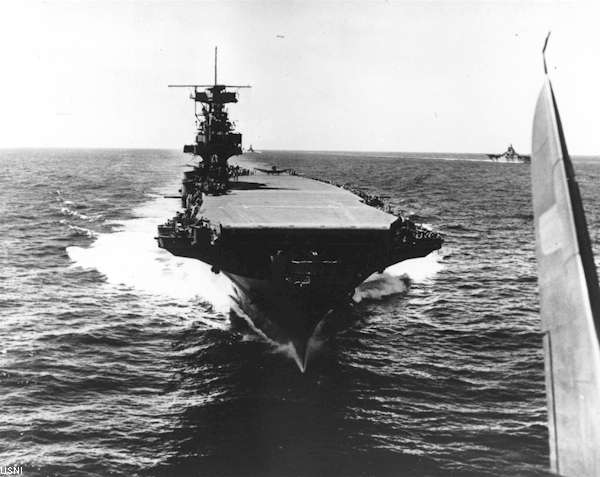
Enterprise in July 1944
The next day the Jap fleet was located and the carriers in the various task forces launched their attacks. The planes from the Enterprise were responsible for sinking one of the Jap carriers. When the battle was over, Japan had been utterly defeated, loosing over four hundred planes and three carriers. The US Fleet withdrew to refuel and regroup and then the Enterprise returned for one more attack on enemy positions on Guam on the 5th of July. After that, The Big E was detached from the fleet with orders to proceed to Pearl Harbor for upkeep and maintenance. During the last six months, the Enterprise had sunk nineteen ships and shot down three hundred enemy aircraft, plus untold damage to shore installations.
On the 15th of July 1944 the Enterprise steamed into Pearl Harbor. For Gordon, it was the last time. On the 26th of July, Gordon was one of nine hundred and seventy-five men to leave the ship. He had served aboard her since December 8, 1941. At one time just before leaving the ship, his pay number was 513, meaning that five hundred and twelve men out of three thousand that had been aboard longer than him. He and the U.S.S. Enterprise CV-6 had fought in seventeen battles together and he fought two by himself, Pearl Harbor and the Battle of Nelson's Cafe.
Gordon later reflected, "I often wonder what I ever did to be in Pearl Harbor like I was and then to end up on the Enterprise. I had to of had someone riding around in my back pocket because I walked off that ship without loosing a single drop of blood.”
The Enterprise went back to sea without Gordon. During the remainder of the war, she continued her outstanding performance until May of 1945 when a Kamikaze, or suicide plane, crashed into her forward elevator blowing it four hundred feet in the air. The Enterprise spent the rest of the war in Bremerton for repairs. During the War, the Enterprise won for herself a fame that has not be topped. The most famous warship in the history of any navy had sunk seventy-one ships and damaged one hundred and ninety-two others. Her guns and planes had downed nine hundred and eleven planes. She had been damaged nineteen times by direct hits and near misses, but was was always back in the ring for the next round of action.
After a few days at Pearl
Harbor, Gordon rode a troopship, the S.S. Sea Cat, to Alameda,
California, arriving on August 3rd. He stayed in Alameda
for seventeen days before being assigned to CASU 7 (Carrier Aircraft
Service Unit) at the Sand Point Naval Air Station in Arlington,
Washington near Seattle. He was granted a twenty three day leave
before reporting to his new assignment. He rode the train home to
Burley and spent two weeks at home. On his way to Seattle, he spent a
few days in Portland. 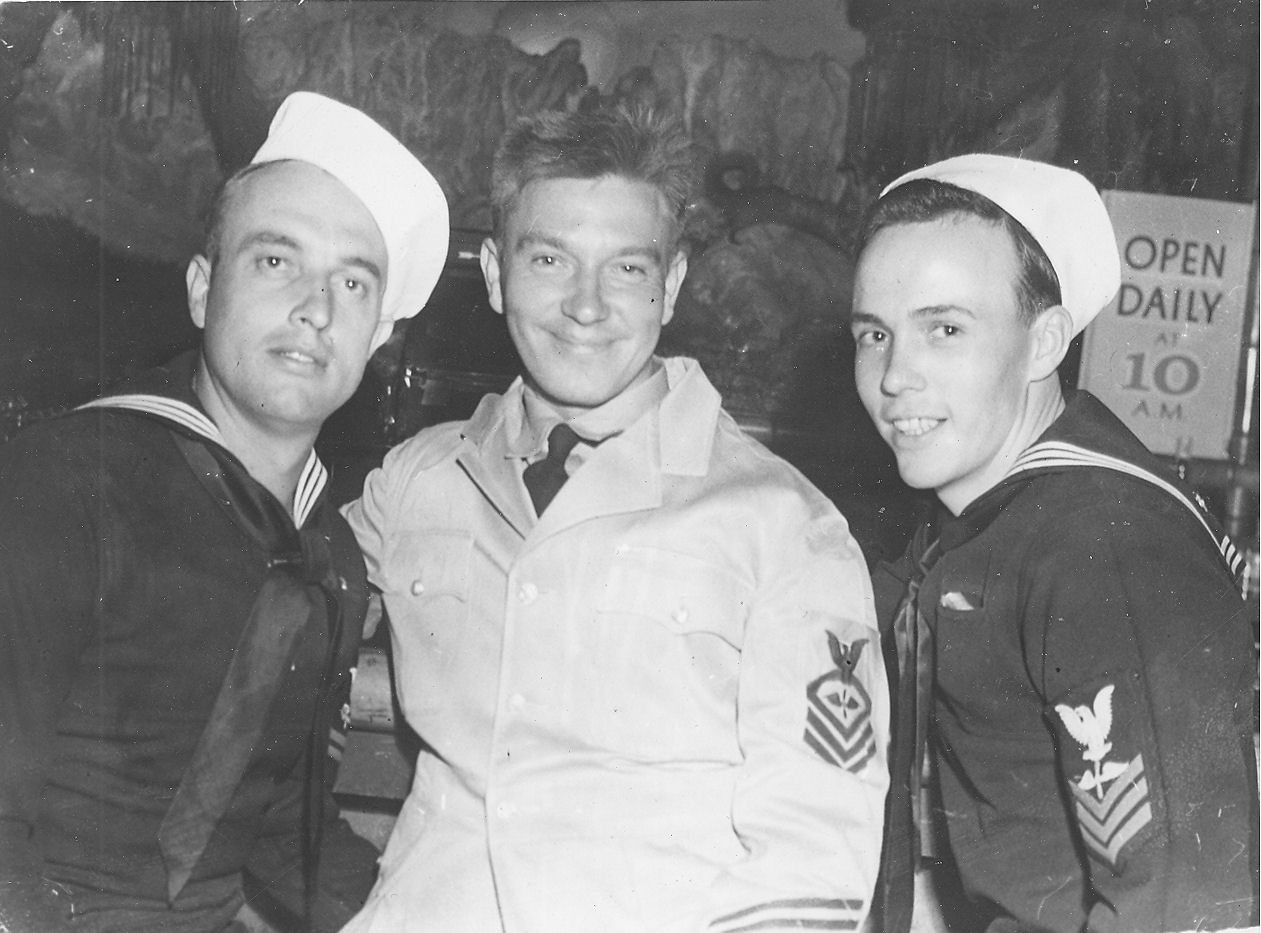
Gordon and some shipmates at the The Jade
Hula Shack in Oakland, California - August 1944
Gordon reported for duty with CASU 7 on September 14th. At this facility, they serviced engines, airframes, propellers, instruments, and electronic equipment.
A seagoing sailor is different from a landlubber, especially after being at sea for almost three years, Gordon really didn't feel like he fit in. It seemed to him that the seagoing sailors always had sea duty and the shore based sailors were always ashore. He didn't last very long there and after a few months he was transferred to CASU 55 and reported for duty at Astoria, Oregon on February 7, 1945.
When he reported in to
the division officer, Gordon was afraid his next move was going to be
back to sea. As he was reporting to Lt. Atwater, the window which had
been propped up, fell with a bang. He threw his arms in the air and
let out a war hoop. He had no sooner gathered himself up from that
when a sailor took a picture behind him. As the flash went off he
went through the commotion again. From being in battle for so long,
he was "shell shocked" or suffered from war neurosis. That
was the reason for being taken off the ship. Lieutenant Atwater
understood the problem and took it easy on Gordon.

The Supply Division at CASU 55. Gordon is in the
front on the left. Lt. Atwater is at the far left.
Milton was stationed not far away at Corvallis, Oregon. They went on liberty several times together. It was there that Wilton married Mildred Pauline Lewis on February 28, 1945. While Gordon was in Astoria, Gover took a trip to Oregon and spent about a week there.
One day in July, Lieutenant
Atwater called Gordon in and asked him if he wanted to go back to
sea. There was a carrier needing an experienced aviation store
keeper. Gordon's reply was, "Please, Mr. Atwater. I'd really
rather not. I know that my shore duty time is up but can't you send
one of these kids. They have never been at sea and are dying to see
some action."
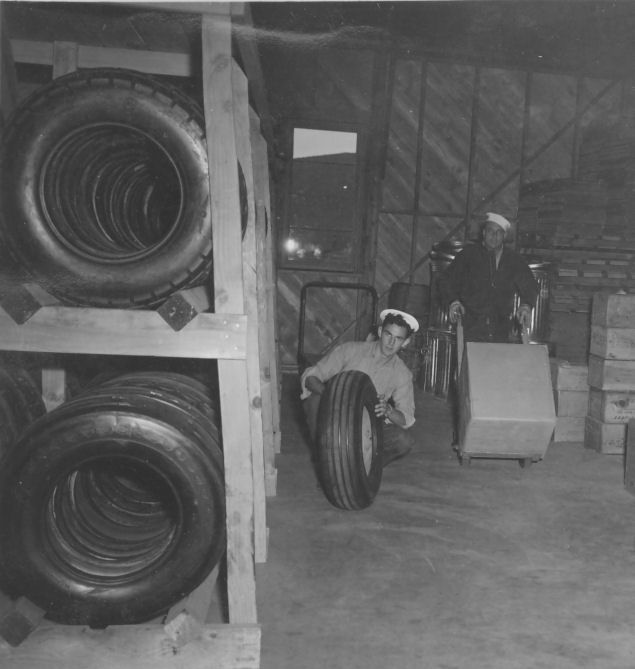
The CASU 55 storeroom. Gordon is in the back.
“Don't you want to know what ship it is” he was asked by the Lieutenant.
"Not really, sir. I don't even care to know."
"It is your old ship."
Gordon's face turned white. "Oh, please no, Mr. Atwater. I've had enough. Can't you send someone else?"
"Okay, Gordon. I just wanted to give you the first choice."
Just three weeks later the
atomic bombs were dropped on Hiroshima and Nagasaki. On September 2,
1945 Japan surrendered. Had he known then that the war would soon end
and the Enterprise would not sail into battle again, Gordon might
have re-enlisted and gone back aboard. He could have sailed through
the Panama Canal and into New York Harbor on Navy Day in October
1945. At New York, the hanger deck and other available compartments
were lined with bunks before sailing to Liverpool, England twice and
once to France to bring the troops home from Europe.

Milton and Gordon - 1945
The Enterprise was placed in reserve and later decommissioned and placed in mothballs until she was broken up for scrap metal in 1959. The U.S.S. Enterprise is truly the most famous warship in history. During the war years she was an important part of victory as well as an important part of Gordon's life. But deep down, he knew that the Navy wasn't the place he wanted to spend the rest of his life.
Gordon was to have been discharged on the 26th of September, but he was in Portland on liberty and didn't get back in time. The next opportunity was the 6th of October. Needless to say, he didn't miss it this time. In order to be discharged he needed to have so many points. Points were awarded for being married and so many for each child. The first two didn't concern him. Where Gordon's points came from where each month at sea and each battle he had been in. To get out, he needed to have 165. He had 280.
After being discharged on October 6, 1945, he came home to Burley with seventeen battle stars. Just over four years after joining the Navy.